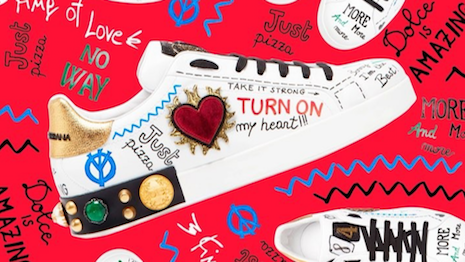- About
- Subscribe Now
- New York,
September 14, 2017

 Dolce & Gabbana looks into sneaker designs. Image credit: Dolce & Gabbana
Dolce & Gabbana looks into sneaker designs. Image credit: Dolce & Gabbana
Sports footwear is on point to become a major component of the luxury shoe market, according to new research from Fashionbi.
The subsegment of the footwear industry has seen a 7 percent compound annual growth rate, which is leading the entire footwear industry. This will likely continue to trend upward with demand and sales rising.
“Footwear is the fastest growing segment inside the fashion industry and the sports shoes are the fastest growing product type of the footwear market, especially taking into consideration the popularity of the sports shoes (aka sneakers) for the evening and casual looks,” said Yana Bushmeleva, chief operating officer at Fashionbi, Milan.
Footwear trends
According to Fashionbi's The Footwear Market marketing research, non-athletic footwear was considered the largest market share world wide with 52.9 percent. In terms of gender, women’s shoes was considered the largest segment with 145 billion in revenue in 2015 and 53.9 percent of market share.
Men’s followed far behind with 28.1 percent and kids at 18 percent.
Example of men's footwear. Image credit: Fashionbi.
While this is unexpected, as women have long been considered the footwear industry’s most lucrative clientele, men are likely to rival women in the future as they continue to grow as fashion buyers. Many menswear stores are currently retooling their strategies to better showcase footwear, paralleling consumer interest.
In 2015, department stores were noted as the biggest avenue for footwear purchasing and online purchasing only at 10 percent, but growing.
Within the past three years a variety of trends have risen including new men’s strategies, unisex style growth, customization, technology innovation, celeb collaborations, slippers, slide-ons and sneakers.
Kering's Gucci, for example, has propelled the slipper movement forward after it launched a design in 2015, which became increasingly popular.
Growth of sneakers
Sneakers are becoming a major point in footwear. In 2015, the sneaker accounted for $55 billion worldwide, and it continues to rise.
The sports footwear trend has even impacted the red carpet with many celebrities and individuals styling sneakers instead of heels.
Examples of sneakers. Image credit: Fashionbi.
Designers are also looking to creative ways to design with the athletic wear. For instance, fashion designer Karl Lagerfeld went off the wall via a collaboration with Californian skateboard shoe brand Vans.
Mr. Lagerfeld designs for three full-time labels—his namesake line, Chanel and Fendi—in addition to working on a number of hobby projects such as photography, lending his skills to fashion houses and international magazines. For the Karl Lagerfeld label, the designer often collaborates with other brands to enter new product categories including cosmetics, hospitality and now sneakers (see story).
Also, Dolce & Gabbana placed emphasis on its footwear category with the opening of a dedicated sneaker boutique in Milan.
Located at Via Della Spiga 1, Dolce & Gabbana’s sneaker boutique sold a collection of the brand’s colorful, graffiti- and patch-adorned tennis shoes. With luxury’s continuous shift toward casual dress, high-end sneakers are an ideal way for brands to leverage creativity with craftsmanship (see story).
“The personalization and customization trend is growing inside the footwear market. Nowadays Jimmy Choo is not the only brand to engrave your initials on the sole of the wedding shoe. Havaianas also launched wedding collection where the clients can personalize the sandals with pins, Dolce&Gabbana with Yeezy offers unique drawings, and so on,” Ms. Bushmeleva said.
“[As far as] future innovations, footwear brands are using technology in various ways, for example, smart shopping, augmented reality through apps, smart shoes and self-lacing shoes, and 3D printed shoes,” she said.
Share your thoughts. Click here